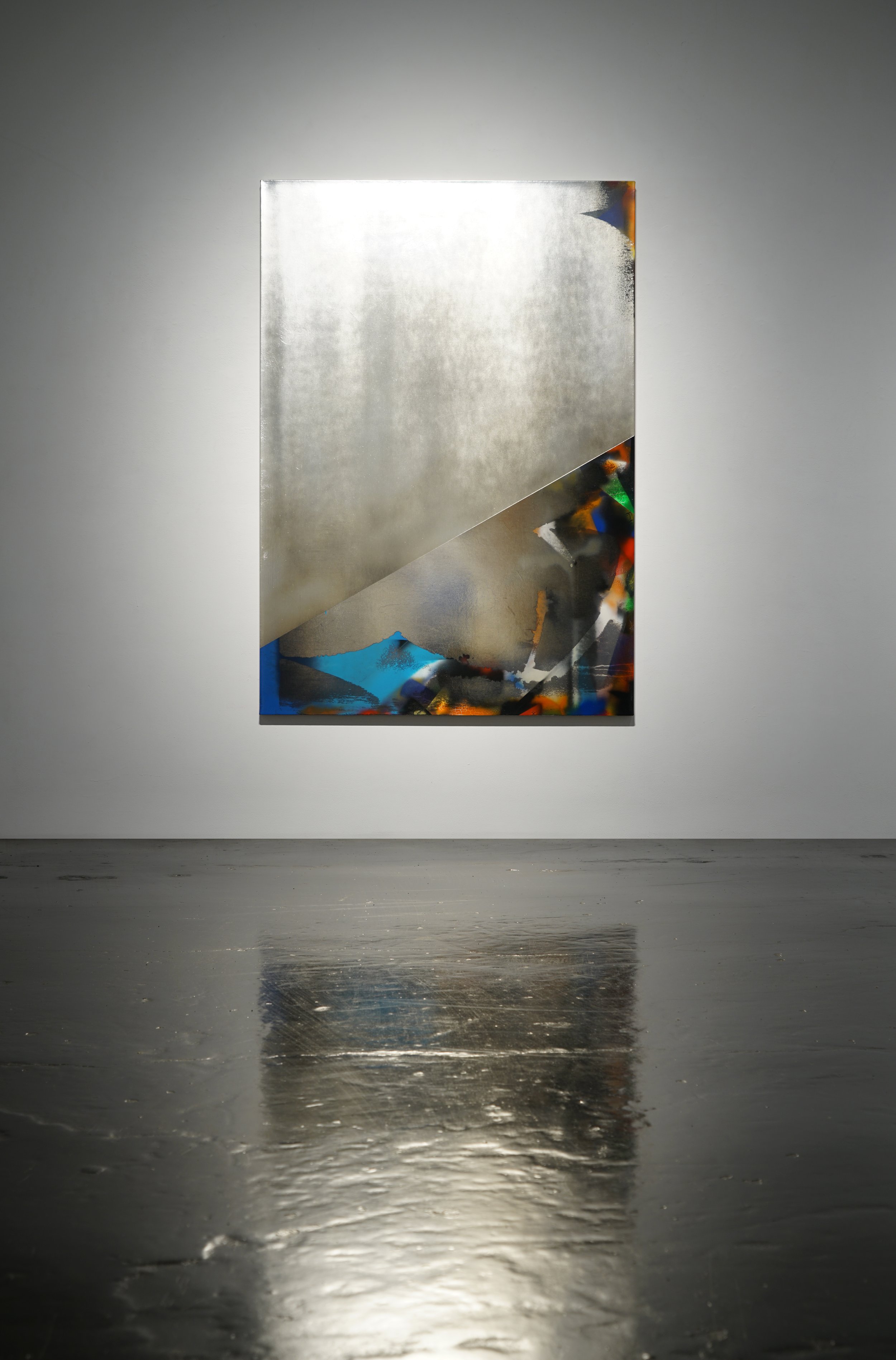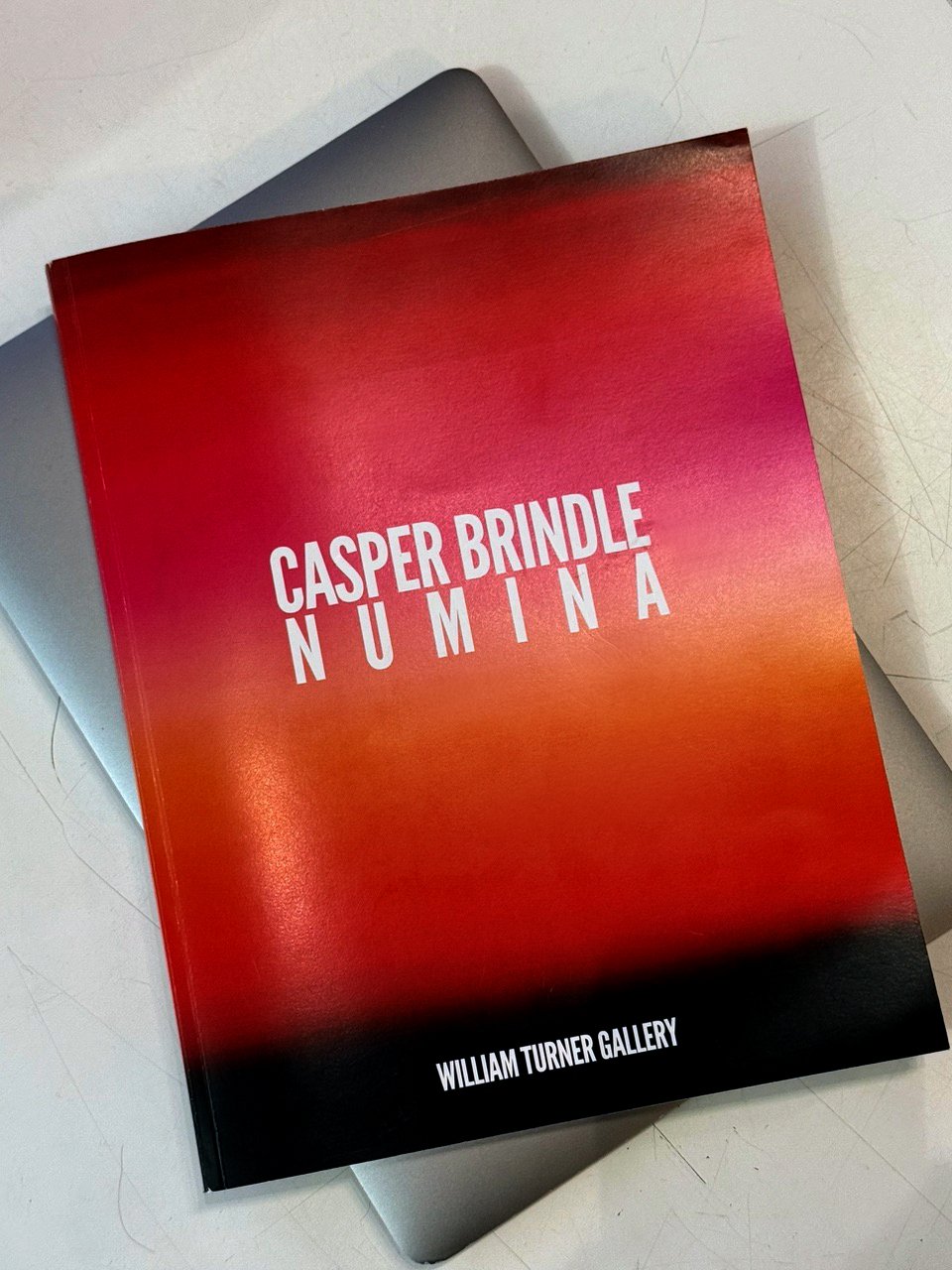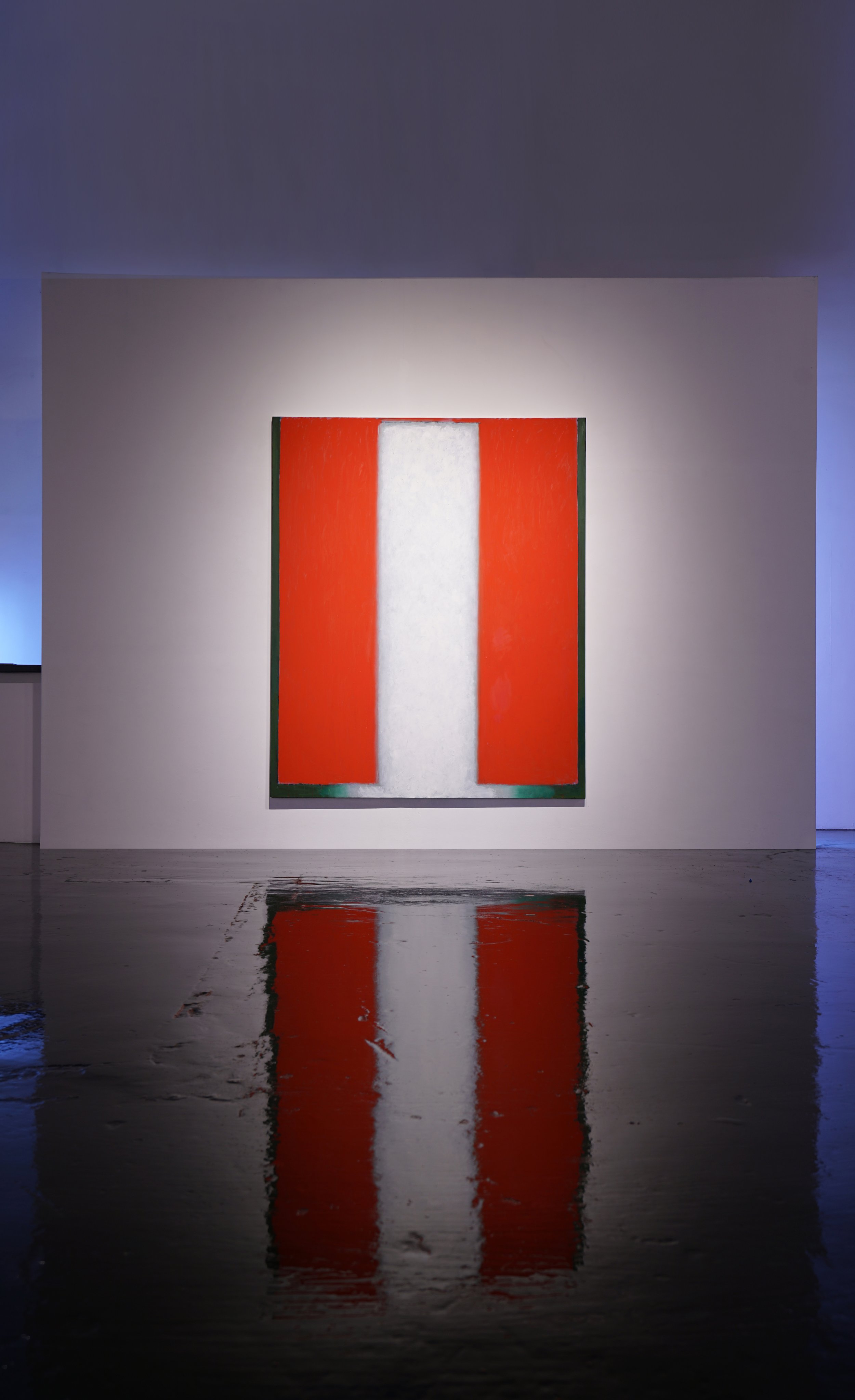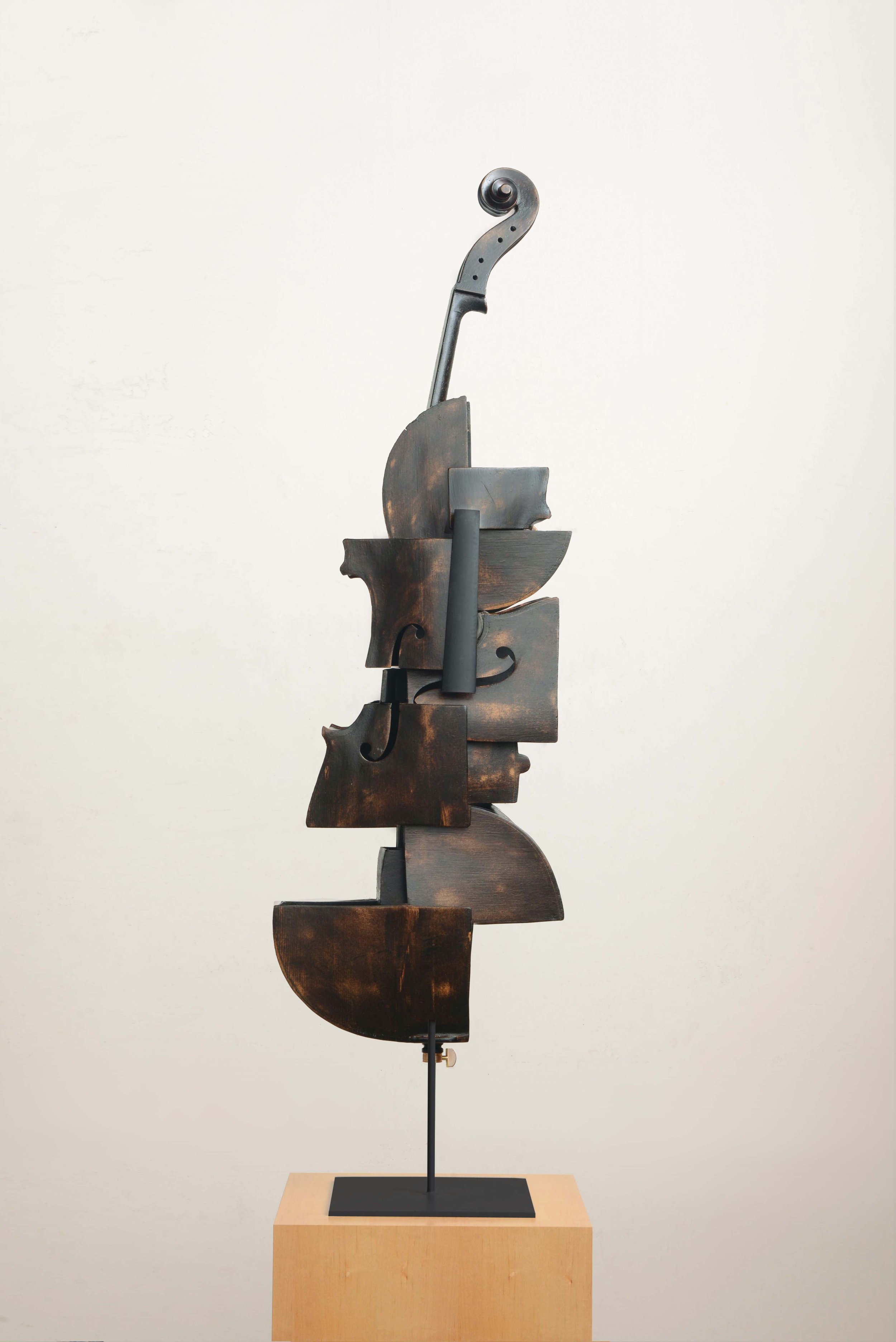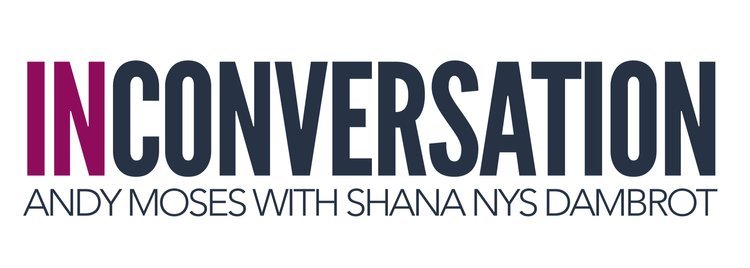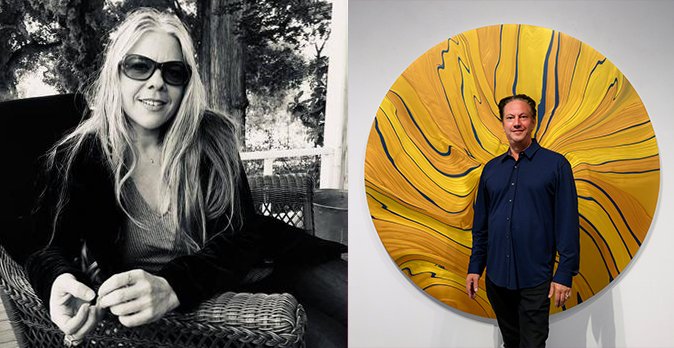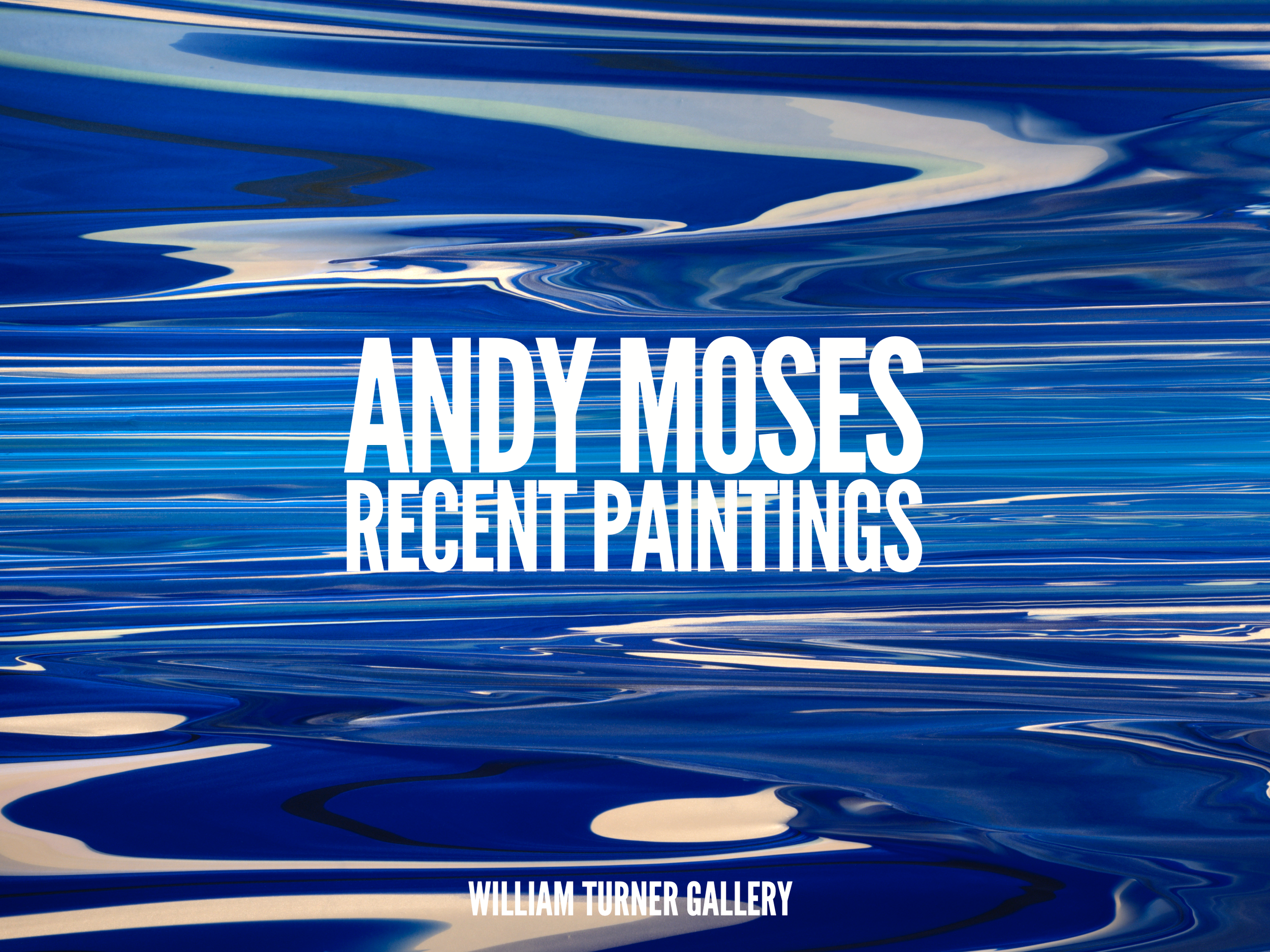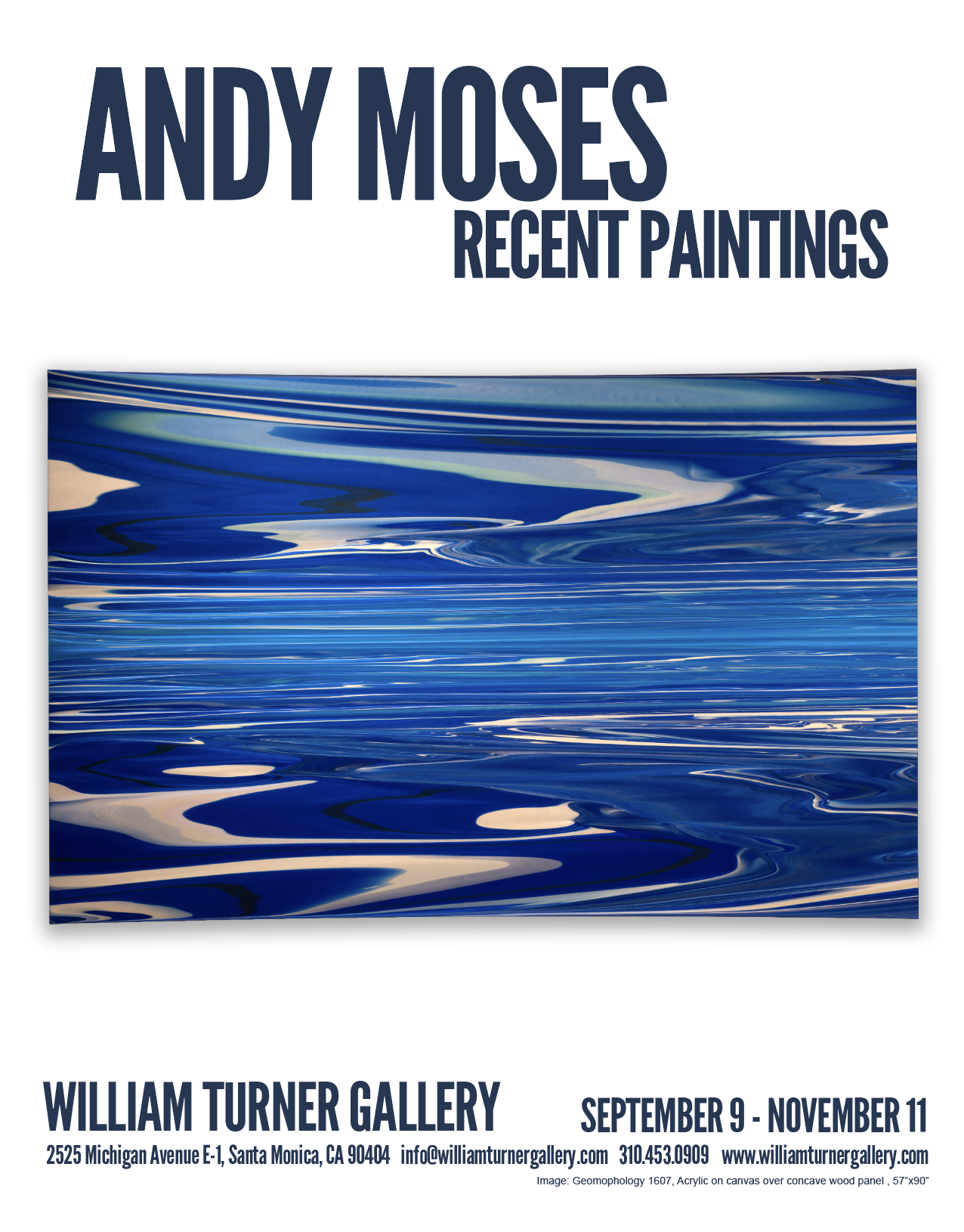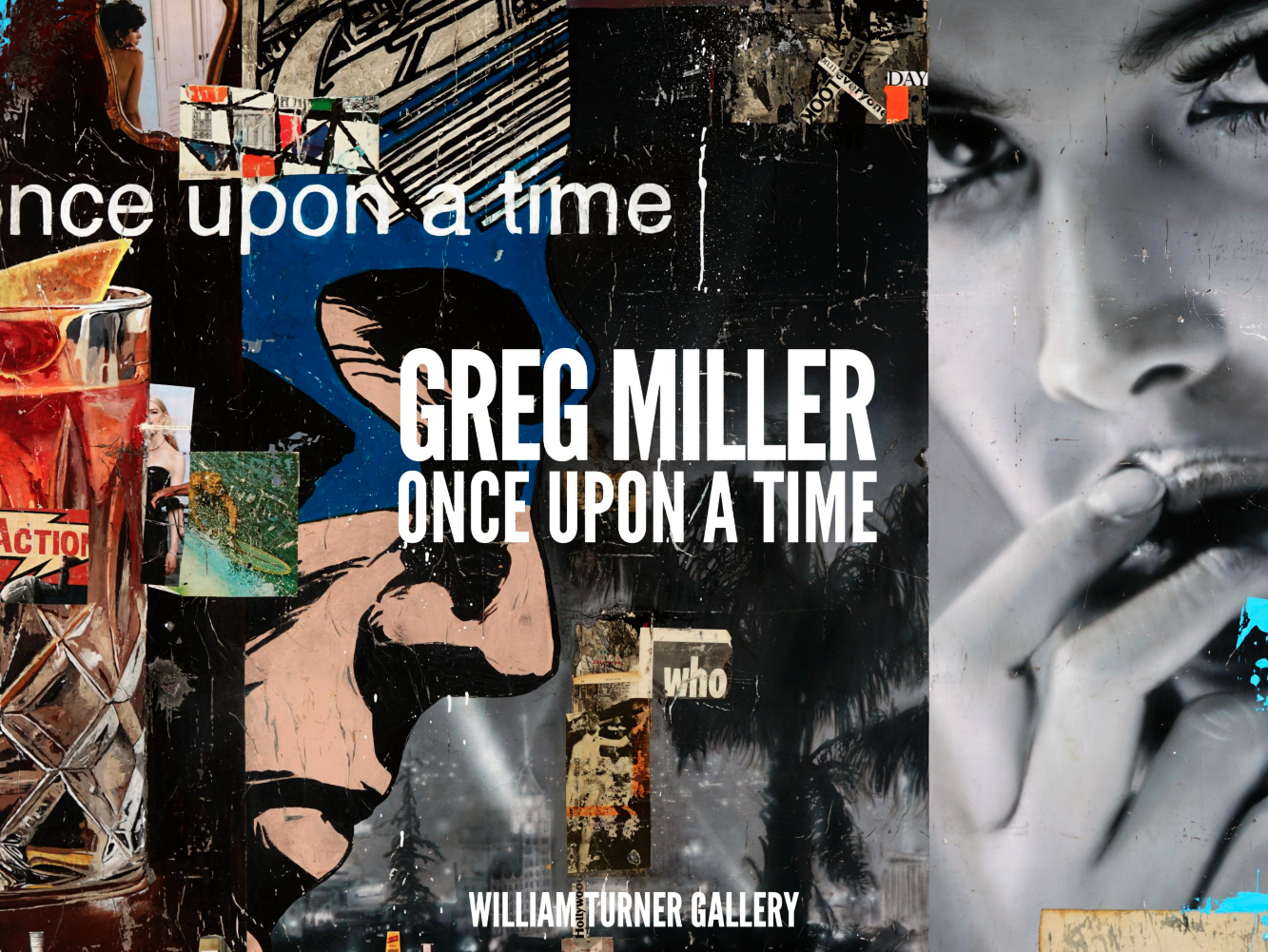JIMI GLEASON: VAPOR WAVE - Opening Tomorrow, Saturday, April 5, 5-8PM
/Santa Monica, CA - William Turner Gallery is pleased to present Vapor Wave, a solo exhibition by Jimi Gleason, opening April 5 and running through May 31, 2025.
Vapor Wave is Jimi Gleason’s most ambitious body of work to date. Utilizing a rich vocabulary of materials and styles, Gleason has built up gossamer thin layers of iridescent paint to create a series of paintings that are engagingly enigmatic. They confirm an artist at the height of his talent, confidently exploring the power of nuance and understated expression.
In this new series, vaporous ribbons of color play across lustrous surfaces that morph and shift as one engages them. The effect elicits a sense of unexpected revelry - much like the kind one might experience gazing across a lake in a predawn moment, captivated by the growing light as it caresses and undulates across the water’s surface.
And like water, Gleason’s surfaces are quietly in motion, their iridescent paints subtly shifting in hue as light plays across them. In some of the canvases, sharp diagonals bifurcate the compositions, providing dramatic structural rifts to these ethereal surfaces. The effect is a hypnotic and prismatic visual structure, where light, color and form intersect in ever-changing play. Gleason has a uniquely personal connection to water: he grew up surfing, and took up rowing in college. When he talks about his work he also talks about, “the way the light looks underwater,” and early mornings rowing when the calm water reflects the sky at dawn.
Like many artists working in the Light and Space arena, materials and their catalytic visual effects are essential to their work. In Gleason’s case, he employs silver nitrate and pearlescent paints to activate his surfaces, which catch and reflect surrounding light, further engaging one’s sense of the surrounding space. Gleason is a leader in that next generation of Southern California artists to work in the Light and Space ethos, carrying the dialogue forward and using his work of art to explore the phenomenological properties of perception.
Born in Newport Beach, CA, Gleason received his BA from UC Berkeley in 1985. He studied printmaking at the San Francisco Art Institute before relocating to New York City, where he worked as a photo assistant and technician. Returning to California, Gleason was employed in the studio of Ed Moses for five years. Combining the disparate technical and compositional skills developed during his exposure to printmaking, photography and mixed media painting, Gleason is now the subject of considerable curatorial and critical attention.
Gleason’s work is exhibited in significant public institutions, including the Hammer Museum, the Frederick R. Weisman Foundation, the Long Beach Museum, the Seattle Art Museum, and the Tucson Museum of Art.The artist’s paintings are actively collected by a growing number of major public and private collections around the world.
NUMINA - Closing Reception & Book Signing Featuring Music by Tom Hiel & the Poetry of Robert Sobul
/William Turner Gallery invites you to join us in celebrating the closing reception and catalogue-signing for Numina on Saturday March 22 from 4 to 6pm. The last day to see Casper Brindle's solo show, Numina, is Saturday March 29!
The reception will feature performances by two Los Angeles-based creatives: pianist Tom Hiel and poet Robert Sobul. Tom Hiel is a pianist and composer, specializing in composing and producing for film and television. Hiel received an MFA in Music Composition from California Institute of the Arts. Writer Robert Sobul studied film at UCLA and screenwriting at the American Film Institute. His reading will include both new and archival work.
Refreshments will be provided!
CASPER BRINDLE: NUMINA - Exhibition Postponed until January 25, 2025
/CASPER BRINDLE: NUMINA
JANUARY 25 - MARCH 22, 2025
Opening Reception:
Saturday, January 25, 5-8PM
William Turner Gallery would like to extend our heartfelt sympathies to everyone impacted by the devastating fires in Los Angeles.
In light of these events, our upcoming exhibition, Casper Brindle: Numina, will now open 5-8 PM on January 25, 2025, a week later than originally scheduled. The gallery will continue to remain open during normal business hours,11AM-6PM Tuesday- Saturday, subject to safety advisories from The City of Santa Monica. Go to santamonica.gov or lafd.org for the latest fire & safety information.
To our wonderful community of artists, patrons, partners, clients, neighbors, we hope you're staying safe and look forward to seeing you soon.
Resources and support for those who need it can be found at the following link:
https://www.lahsa.org/news?article=1014-resources-to-support-those-during-the-l-a-fires
LIGHT MATTER Closing This Saturday - PHENOMENA Phase Two of PST Opens November 16
/Phenomena features a range of work, from representational depictions to abstract expressions, celebrating the power and visual splendor of the natural world as a resource for creative expression and investigation. For centuries, artists have pictorially documented their observational studies of natural phenomena and the world around us. Manuscripts such as Natural History (77 CE) by Pliny the Elder and The Book of Miracles (1552), chronicled divine wonders and horrors in illustrations, often serving as warnings of the consequences of human deeds upon their environment and the mysteries of the natural world. Utilizing these extraordinary codexes as a genesis for Phenomena, the exhibition explores related themes.
In the 16th century, “cabinets of curiosities” or “wonder rooms” in Europe served as spaces to showcase collections curated for the artistic and scientific interests of their patrons and served as precursors to museums. With missions to both amuse and enlighten, “cabinets of curiosities” functioned as sources for entertainment and educational resources, thus intersecting art and science. In the late 19th century, scientific inquiry shifted from museums to university laboratories bifurcating the two discourses. Phenomena merges the two disciplines as they once had been integrated in the cabinets of curiosities.
Artists in Phenomena: Charles Arnoldi, Natalie Arnoldi, Ryland Arnoldi, Kelsey Brookes, Alex Couwenberg, Franco Defrancesca, Lawrence Gipe, David Lloyd, Ed Moses, Jeff Overlie, Melanie Pullen, Jennifer Wolf
LIGHT MATTER a TOP PICK by FITZ & CO
/PST ART: Art & Science Collide is now in full swing.
Now in its third edition, Pacific Standard Time in Los Angeles brings together over 800 artists, 70 exhibitions, and institutions throughout all of Southern California with one central theme: the collision of art and science. The landmark arts event brings the community together to spark meaningful conversations on today’s most urgent issues. Project topics range from climate change and environmental justice to the future of AI and alternative medicine.
“Los Angeles right now is the most creative city on earth at any time in history,” says Michael Govan, the CEO and Wallis Annenberg Director of participating museum LACMA.
Swipe through to see some of our top picks for PST ART, on view across California.
1. ‘Fred Eversley: Cylindrical Lenses’ at David Kordansky Gallery | Installation view of ‘Cylindrical Lenses,’ 2024. Image courtesy of David Kordansky Gallery.
2. ‘Lia Halloran: Night Watch’ at Luis De Jesus Los Angeles | ‘Lia Halloran: Night Watch.’ Image courtesy of Luis De Jesus Los Angeles.
3. ‘Lita Albuquerque: Earth Skin’ at Michael Kohn Gallery | Installation view of ‘Earth Skin,’ 2024. Image courtesy of Michael Kohn Gallery.
4. ‘Light Matter’ at William Turner Gallery | Casper Brindle, “Cuboid 4,” pigmented acrylic, 36 x 15 x 15 inches. Image courtesy of William Turner Gallery.
5. 'Los Angeles Water School (LAWS)' at Morán Morán | Installation view of ‘Los Angeles Water School (LAWS), 2024. Image courtesy of Morán Morán.
6. ‘Max Hooper Schneider - The Unknown Masterpiece’ at the Virginia Robinson Gardens. Presented by Del Vaz Projects, Francois Ghebaly Gallery, and Marc Selwyn Fine Art | Robinson Gardens Pool Pavilion. Image courtesy of Robinson Gardens.
7. ‘Shirazeh Houshiary: The Sound of One Hand’ at Lisson Gallery | Shirazeh Houshiary, “Aurora,” 2023, Pigment and pencil on Aquacryl on canvas and aluminum, 190 x 190 x 5 cm, © Shirazeh Houshiary, courtesy Lisson Gallery.
8. ‘Helen Lundeberg: Inner/Outer Space’ at Louis Stern Fine Arts | Helen Lundeberg, “Cloud Shadows,’ 1966. Acrylic on canvas, 153 x 152.4 cm, courtesy of Louis Stern Fine Arts.
About Fitz & CO…
A growing global footprint continues to make FITZ & CO. a serious player for arty clients with worldwide profiles. About to enter its 25th year, Sara Fitzmaurice’s 20-person agency still reps Art Basel; Gagosian; Storm King Art Center; and brands like BMW and eBay, for whom FITZ & CO. builds artist partnerships. Equinox just tapped the firm to get closer to (real) art/culture influencers, and Mastercard engaged FITZ & CO to extend its Priceless campaign into the cultural sphere. Also in the agency’s collection: ultra-blue-chip international gallery Almine Rech; Dubai’s Alserkal Avenue arts/culture district; Denmark’s ARoS Aarhus Art Museum; ART021 Shanghai Contemporary Art Fair; and the Faurschou Foundation, which operates spaces in Copenhagen, Beijing and NYC.
LIGHT MATTER - PST ART: ART & SCIENCE COLLIDE - Exhibition Catalog Now Available
/William Turner Gallery is pleased to present Light Matter, the first of two exhibitions, in partnership with the Getty’s PST ART: Art & Science Collide, which explore the intersections and influences between art and science.
Light Matter showcases the influences of scientific research on artistic process and intention, and builds on a collaborative experiment that began with LACMA’s innovative Art & Technology program, a collaboration between artists and industry that ran from the late 60s to early 70s. As part of this initiative, Robert Irwin and James Turrell collaborated with NASA scientist and psychologist Ed Wortz at the Garrett Corporation. Together they developed a series of art and science-based investigations into the dynamics of perception, with a special emphasis on sensory deprivation. This intrigued Irwin and Turrell, who began to notice that perceptions were heightened after sessions in sensory deprivation tanks. Perhaps, they reasoned, the purpose of the work of art wasn’t as much about the work, as it was about the experience of perceiving the work. Enter Light & Space in Southern California, where the emphasis shifted from looking at art as “object”, to art as “experience”.
Artists in Light Matter continue to expand on this notion, experimenting with the possibilities of their materials, often through scientific research and innovation, to achieve heightened visual effects that engage the viewer in the wonder of the phenomenology of perception. They utilize materials and approaches that inspire the viewer to reflect - not only on “what” they are perceiving, but “how”. Many of the pieces require the viewer to interact with the works in unexpected ways - either by encouraging unusually active movement around, or stillness before, their works. The act of viewing engages the senses and heightens our sense of perception.
Light Matter includes work by Dawn Arrowsmith, Larry Bell, Casper Brindle, Shingo Francis, Jimi Gleason, Eric Johnson, Jay Mark Johnson, Peter Lodato, Andy Moses, and Roland Reiss.
Opening This Evening from 4-8PM - LIGHT MATTER - PST ART: Art & Science Collide
/William Turner Gallery, Santa Monica, California - is pleased to present Light Matter, the first of two exhibitions in partnership with the Getty’s PST ART: Art & Science Collide, which explores the intersections and influences between art and science.
Light Matter explores the influences of scientific research on artistic process and intention, and builds on a collaboration that began with LACMA’s innovative Art & Technology program, a collaboration between artists and industry that ran from the late 60s to early 70s. For a number of artists, this unique program led, unexpectedly, to a significant new way seeing and thinking about the purpose of a work of art. Enter Light & Space in Southern California, where the emphasis shifted from looking at art as “object”, to art as “experience”.
Artists in Light Matter continue to expand on this notion, experimenting with the possibilities of their materials, often through scientific research and innovation, to achieve heightened visual effects that engage the viewer in the wonder of the phenomenology of perception. They utilize materials and approaches that inspire the viewer to reflect - not only on “what” they are perceiving, but “how”. Many of the pieces require the viewer to interact with the works in unexpected ways - either by encouraging unusually active movement around, or stillness before, their works. The act of viewing engages the senses and heightens our sense of perception.
Light Matter includes work by Dawn Arrowsmith, Larry Bell, Casper Brindle, Shingo Francis, Jimi Gleason, Eric Johnson, Jay Mark Johnson, Peter Lodato, Andy Moses, and Roland Reiss.
Dawn Arrowsmith’s paintings are meditations in color, engaging the viewer in a kind of minimalist luxury – pure, distilled, but also rich, and luscious. Her work is intuitive, greatly influenced by Buddhist philosophy and by her travels to the Orient. These pieces play on the retinal effects from extended viewing, where an image that appeared flat & monochromatic takes on volume and appears to shimmer. Arrowsmith’s paintings, sculptures and installations have been exhibited in the USA and abroad. Exhibitions sites include the Los Angeles Contemporary Exhibitions (LACE), the Hammer Museum of Art in Los Angeles, the Los Angeles County Museum of Art, the Los Angeles Municipal Art Gallery (Barnsdall), the Clark Humanities Museum Gallery in Claremont, CA, the Riverside Art Museum, the Eli Broad Foundation in Los Angeles, the Lidovy Gallery in Prague, Czec. and the Campo d'Osservazione in Gubbio, Italy. Arrowsmith was born in San Francisco, California and received her M.F.A. at Claremont Graduate School, Visual Arts, Claremont, California.
Larry Bell is one of the most renowned and influential artists to emerge from the Los Angeles art scene of the 1960s, alongside Ferris Gallery contemporaries Ed Ruscha, Billy Al Bengston, Ed Moses and Robert Irwin. Bell is known foremost for his investigations of the properties of light, reflection and shadow on various surfaces, and how these properties affect our sense of space. Bell’s significant oeuvre extends from painting and works on paper to glass sculptures and furniture design. About his sculptures, he has said: “Although we tend to think of glass as a window, it is a solid liquid that has at once three distinctive qualities: it reflects light, it absorbs light, and it transmits light all at the same time.” Harnessing a little known technique developed for aeronautics, Bell utilizes a high-vacuum coating system that allows him to deposit thin metal films, which catch and reflect light, onto a variety of surfaces, which include his glass sculptures, paintings and works on paper. Bell’s work is in the permanent collections of numerous museums, including Museum of Modern Art, NY, Museum of Contemporary Art, LA, Los Angeles County Museum of Art, Frederick R. Weisman Art Foundation, LA, among many others.
Casper Brindle has become widely recognized for paintings and sculptures that invite the viewer into a rhythmic dance with light, as it is reflected, diffused and distilled through his work. Brindle also utilizes a variety of industrial materials - airbrush, auto paints, resin, and pigmented acrylic - to create sculptures and paintings that shift and change as one moves around them. Atmospheric colors are encased in cultural surfaces in a constant push and pull between depth, light and color. Casper Brindle grew up surfing the beaches along LA's coast during the 1970's and 80's, and worked for Light and Space artist, Eric Orr, in the late 1980’s. Brindle’s work is in the permanent collection of the Frederick R. Weisman Art Foundation, CA and has been exhibited at the Museum of Art and History in Lancaster, CA and the Laguna Art Museum in Laguna Beach, CA.
Shingo Francis grew up in Los Angeles, immersed in the intense light and vast ocean vistas of life in southern California. Like many LA artists, Francis became fascinated with the ever-changing qualities of light and how it affected one’s perception and experience of the world. As the son of painter Sam Francis, Shingo also happened to grow up in the heart of LA’s nascent art scene, where artists such as Larry Bell, Robert Irwin, James Turrell, Craig Kaufman and Peter Alexander were utilizing new materials to explore the effects of light on perception. Francis has continued this pursuit with a series of gossamer-like paintings with colors that appear in constant flux, changing as one moves about them. Utilizing interference paints – a medium of crushed, titanium-coated mica that refracts light - the colors in these pieces shimmer and shift depending on the angle of the viewer and the reflection of light. Rectangular shapes conform to the shape of the canvas, creating a framework of change as viewers move. What one sees becomes inherently tied to their particular perspective and the character of the light at any given time. Shingo Francis has been the subject of numerous national and international exhibitions. He was awarded the Fumio Nanjo Award from the Mori Museum in Tokyo and is in numerous museum and institutional collections, including The Frederick R. Weisman Foundation in Los Angeles.
Jimi Gleason has spent his career exploring the reflective possibilities of light. Mixing nontraditional materials such as silver nitrate with pearlescent paints, Gleason’s surfaces are highly reactive to light and shifts in the viewer’s position. His silver deposit surfaces act as enigmatic mirrors that are activated by the viewer and the environment in which they are situated. Light, color and form are in constant flux with the external world, inducing an interactive, meditative experience with the viewer. Jimi Gleason was born and raised in Southern California. He graduated with a BA in Fine Art from UC Berkeley in 1985, later moving to New York. Upon his return to California, Gleason worked as a studio assistant for renowned painter, Ed Moses. Gleason’s work is in numerous public and private collections, including the Frederick R. Weisman Art Foundation, CA, the Laguna Art Museum, CA, and has been exhibited at the Hammer Museum, CA, the Long Beach Museum of Art, the Seattle Art Museum and the Tucson Museum of Art.
Eric Johnson utilizes polyester resin and color-shifting pigments, to create sculptures that are exquisitely sensual and dynamic in how they reflect and absorb light. They recall the materials of the surf and car culture of the late 60s and early 70s in Southern California, employed by many artists like DeWain Valentine, Craig Kaufman and Billy Al Bengston. Johnson embraced the hot-rod culture as well and has made customized car bodies for the Porsche 962 and has lovingly overhauled vintage cars-as evidence by the two toned 1939 Chevrolet panel truck and fire engine red 1934 Ford pickup that sit to one side of his studio. As often was the case for many artists working in the 1970s, industrial products found their way into Johnson’s early studio practice and have remained there ever since. “I’ve translated all that automotive knowledge into making my artwork”,” he says. “I use the full array of auto tools and pigments.” The handcrafted abstract works are sheathed in resin skins, often revealing glimpses of skeletal armatures and hidden architectures. Other influences have been the aerospace industry and an ancestral boat builder heritage. Initially the constructs hid their “bones” under a “skin”, time capsule artifacts within. Over the past twelve years, the structures have become more organic and revealing. The current work merges Johnson’s passion for depth and structure with an obsession for color and surface. Johnson’s work is in the collections of the Oakland Museum, CA, the Laguna Beach Museum, CA, the UC Irvine Museum, CA and the Hamano Institute, Tokyo, Japan.
Jay Mark Johnson has rigorously pursued the possibilities of timeline photography over the last two decades. His artwork captures the fluid gestures of Tai Chi and dance, the rush of cars, trains and people, and the infinite cycling of beachfront waves. But within his images the rules for representing reality have shifted. Shadows are crisscrossed and the relative speed of an object determines its size. Moving objects appear isolated from their backgrounds and the backgrounds themselves have been decimated. In this manner, the results of Johnson’s process become a metaphor for the process itself. Held by prestigious private institutions and public collections throughout the U.S. and Europe, Johnson’s work has been exhibited and collected by the Museum of Modern Art, the Smithsonian Institution, Art Institute of Chicago, Frederick R. Weisman Art Foundation, the Langen Foundation and Zentrum für Kunst und Medientechnologie, Karlsruhe.
Peter Lodato began making work in the late 1960s as part of the West Coast-specific Light and Space movement. Aligned with the concerns of his contemporaries, Lodato first constructed light installations that explored the nature of perception and the way that physical environments could be transformed into immersive experiences for the viewer. Lodato’s paintings evolved from his preliminary drawings for these installations and eventually, Lodato was able to recreate the illusive effect of light with color, form, and canvas alone. Always fascinated by the uncertainty of human perception, and the duplicitous nature of vision, which can be both revealing and deceitful, Lodato creates paintings that delve into this duality. Initially, Lodato’s paintings appear as austere, geometric abstractions. Yet, upon further observation, the paintings begin to vibrate: brushstrokes become evident and the surface reveals that there are numerous layers beneath. The hard edges of his often bi-chromatic works dissipate into sensuous fields of color that seem to push space in and out. Lodato’s reductive, divided compositions are visual confrontations between the planar simplicity of form and the resonance of particular pigments. A disciple of the AbEx color field painter, Barnett Newman, Lodato’s sumptuously colored canvases echo Newman’s concept of using division as a way to merge different areas of the canvas into a sublime whole. Much like Newman’s “zips” of color, Lodato’s vertical bands draw the viewer deeply into the picture plane, causing them to intensely experience the work, both physically and emotionally. The Frederick Weisman Foundation curated an extensive solo retrospective of Lodato’s work in 2000 and his work has been exhibited at the Whitney Museum of American Art, the Museum of Contemporary Art in Los Angeles and the Los Angeles County Museum of Art. Peter Lodato is in numerous esteemed collections both public and private including the Brooklyn Museum, the Seattle Art Museum, the Dallas Museum of Art and the San Diego Museum of Contemporary Art.
Andy Moses, utilizes techniques that facilitate his almost obsessive study of the alchemical properties of paint. The paintings that emerge articulate the abstract nature of perception, reaching beyond the material and tapping into the visceral. The images reveal undeniable traces of natural phenomena, seeking not to replicate the natural world, but to replicate the forces of nature itself. The artist’s complex process of mixing and pouring paint conveys a sense of undulating energies pushing and pulling within the rectilinear and circular forms of the canvases themselves. The paintings are sweeping and luminescent, their lustrous surfaces seemly executed with an impossible combination of absolute precision and wild improvisation. Meandering lines of psychedelic chroma oscillate between vivid sharpness and dissolving washes of color, achieving works of captivating presence. Viewing the work from multiple perspectives, one is swept into an interactive dance, as light plays across the surfaces in lustrous, ever-changing hues. Andy Moses is in numerous important private and public collections, including the Frederick R. Weisman Art Foundation, CA, the Los Angeles County Museum of Art, CA, the Laguna Beach Museum, CA, and has been exhibited at the Laguna Art Museum, CA, the Bakersfield Museum of Art, CA, the Lancaster Museum of Art & History, CA, the Frederick R, Weisman Art Foundation, CA, and California State University. He received his BFA from Cal Arts and lives and works in Venice, California. Andy Moses just enjoyed a survey exhibition at the Santa Monica College Pete and Susan Barrett Art Gallery that explored 30 years of his artistic output.
Roland Reiss was born in Chicago in 1929 and had a long and influential history in the LA art scene. Reiss’ early work owed a lot to Abstract Expressionism, but while he was teaching at the University of Colorado in the late 60s, Reiss began experimenting with the dynamic properties of resin and new plastic materials to explore their interactive properties with the viewer. Reiss soon moved towards making work informed by the Conceptualist movement of the 70s, but he had a profound impact on one of his students, who also began making resin sculptures. That student was DeWain Valentine, who would become one of LA’s most significant Light & Space artists. At the apex of his career, Reiss felt “I have no more stories to tell.” As critics and curators declared painting dead, he had already started investigating hundreds of studies for painting. His intent was to “take painting beyond where it has been,” believing it is impossible to deplete the possibilities of any medium. What seems like the product of gestural spontaneity are actually extensively rehearsed moves. He describes his work as “energy fields and spaces in which forms are operative and you can interact with visually. ”After earning BA and MA degrees at UCLA (1952-56), he taught at the University of Colorado, Boulder, and, in 1971, was named Chair of the Art Department at Claremont Graduate University. At CGU he held the Benezet Chair in the Humanities, and in 2010, an endowed chair in art was established in his name. His work has been exhibited internationally, recognized by no fewer than four NEA Visual Arts Fellowships, among many other honors, and is to be found in the permanent collections of major museums and private collections in this country and abroad, among them the Hammer Museum, CA, the Oakland Museum, CA, the Laguna Beach Museum, CA, and the Orange County Museum of Art, CA.
September 14 - November 2, 2024
Opening Reception: Saturday, September 14, 4-8PM
Opening This Saturday 4-8PM - LIGHT MATTER - PST ART: Art & Science Collide
/William Turner Gallery, Santa Monica, California - is pleased to present Light Matter, the first of two exhibitions in partnership with the Getty’s PST ART: Art & Science Collide, which explores the intersections and influences between art and science.
Light Matter explores the influences of scientific research on artistic process and intention, and builds on a collaboration that began with LACMA’s innovative Art & Technology program, a collaboration between artists and industry that ran from the late 60s to early 70s. For a number of artists, this unique program led, unexpectedly, to a significant new way seeing and thinking about the purpose of a work of art. Enter Light & Space in Southern California, where the emphasis shifted from looking at art as “object”, to art as “experience”.
Artists in Light Matter continue to expand on this notion, experimenting with the possibilities of their materials, often through scientific research and innovation, to achieve heightened visual effects that engage the viewer in the wonder of the phenomenology of perception. They utilize materials and approaches that inspire the viewer to reflect - not only on “what” they are perceiving, but “how”. Many of the pieces require the viewer to interact with the works in unexpected ways - either by encouraging unusually active movement around, or stillness before, their works. The act of viewing engages the senses and heightens our sense of perception.
Light Matter includes work by:
Dawn Arrowsmith
Larry Bell
Casper Brindle
Shingo Francis
Jimi Gleason
Eric Johnson
Jay Mark Johnson
Peter Lodato
Andy Moses
Roland Reiss
September 14 - November 2, 2024
Opening Reception: Saturday, September 14, 4-8PM
Mark Steven Greenfield Opening Tomorrow at the Ronald H. Silverman Gallery at Cal State LA
/AURAS: New Icons by Mark Steven Greenfield
in collaboration with William Turner Gallery
curated by Mika M. Cho
August 19 – October 22, 2024
Artist Reception:
Saturday, August 24, 2024, 5 - 8 PM
Ronald H. Silverman Fine Arts Gallery
5151 State University Dr, Los Angeles CA 90032
MAP
Francisco Manicongo, 2024, Acrylic and Gold Leaf on Wood Panel, 20 x 16 in.
“My work concerns itself with the complexities of the African American experience, both historically and in contemporary society. The work often revolves around a number of themes which include subjects as diverse as African American stereotypes, spiritual practices, social justice, meditative practices and abstraction based on my interpretation of the process by which images are formed in the subconscious.” – Mark Steven Greenfield
Mark Steven Greenfield is a painter of phenomenal insight, exemplified by his upcoming exhibition “AURAS: New Icons by Mark Steven Greenfield.” The majority of his paintings in this exhibition are presented for the first time at the Ronald H. Silverman Fine Arts Gallery. These images draw upon issues that have been at play regarding the black identity and black history in the United States. These two series are reflective of the spirituality that permeates the black psyche and reach back into the earliest of experiences of their presence on the American continent or even before, as well as their exposure to the European narratives and their appropriations by the Christianized Blacks. Haloconveys the black spiritual experience through various social, political, and religious signs and symbols by appropriating the icons of the colonizing Europeans.
AURAS, 2024, Acrylic and Gold Leaf on Wood Panel, 30 x 40 in
AURAS: New Icons by Mark Steven Greenfield
ARTIST RECEPTION
Saturday, August 24, 2024, 5 - 8 PM
Conversation between Artist, Mark Steven Greenfield and Art Critic, Shana Nys Dambrot
September 28, 2024, 2 - 4 PM
5151 State University Dr, Los Angeles CA 90032
MAP
PETER LODATO: DIAMONDS/DIVISIONS/VOIDS - Exhibition Catalog Now Available
/Santa Monica, CA - William Turner Gallery is pleased to present, solo exhibition of exceptional new works by Peter Lodato, opening January 13th, 2024.
Peter Lodato’s (b. 1946) artistic journey reflects an evolution, from immersive light installations, to captivating paintings that explore the complexities of human perception over the course of his six decade-long career. In addition, Lodato would himself influence a number of artists, teaching Art History at Art Center in Pasadena, and University of California Irvine with notable students such as James Turrell and Chris Burden.
His initial foray into art consisted of environmental light installations, characteristic of the West Coast's Light and Space movement in the 1960’s, which sought to transform physical spaces into immersive experiences for viewers. He credits the Roman Pantheon’s oculus for his interest in interpreting his experience. This body of work led to his inclusion in the 1981 Whitney Biennial.
As Lodato transitioned back to painting, he carried forward his fascination with perception, creating works that initially appear as austere, geometric abstractions but upon closer inspection, reveal layers, brushstrokes, and vibrant colors that play with space and depth. The dichotomy of vision—its capacity to both reveal and conceal—serves as a thematic cornerstone in Lodato's artistry. His reductive compositions, often featuring divided forms and bold colors, engage viewers in a visual dialogue between simplicity and complexity. Inspired by the Abstract Expressionist’s Mark Rothko and Barnett Newman, Lodato's use of vertical bands of color draws viewers into the canvas, inviting them to experience the artwork both physically and transcendentally. Hard edges feather out into diaphanous atmospheric vapors, creating luminous, Color-field suspensions floating on a colored ground– the formal consequences appear to both recede and project, dematerializing the art object and simultaneously constructing a void of flat, hard-edge, matted pigment. The artists hand is evident in the textural materialization of paint executed with an expert hand. In reasserting the picture plane in favor of the flat form, the abstractions are not in fact “subjectless”, regardless of their reductive nature, they are intended to elicit a deep emotional response and expose the paradoxical nature of human perception.
Informed in part by Eastern philosophy, Lodato’s palette observes the color schema assigned to the various corporeal chakras and their corresponding color assignments. Red for example symbolizes the root chakra at the base of the spine, characterizing strength and vitality, whilst white on the other end of the spectrum, illustrates the crowning light of spiritual wisdom.
Lodato holds a Graduate degree from California State University. His artistic contributions have been recognized through a solo retrospective curated by the Frederick Weisman Foundation (2000), and exhibitions at prestigious institutions such as PS1 in New York City (1978), Whitney Museum of American Art’s Biennial (1981), the Museum of Contemporary Art in Los Angeles, and the Los Angeles County Museum of Art. His works grace esteemed collections in various public and private institutions, including the Brooklyn Museum, the Seattle Art Museum, the Dallas Museum of Art, and the San Diego Museum of Contemporary Art. This extensive presence in renowned collections underscores the impact and significance of Lodato's artistic vision within the realm of contemporary art. He lives and works in Venice, California.
Opening Tomorrow, Saturday, January 13 from 5-8PM - Peter Lodato: Diamonds/Divisions/Voids & Koji Takei: Intertwined
/Vermillion Green & White, 2023, oil on canvas, 96” x 84”
PETER LODATO
Lodato holds a Graduate degree from California State University. His artistic contributions have been recognized through a solo retrospective curated by the Frederick Weisman Foundation (2000), and exhibitions at prestigious institutions such as PS1 in New York City (1978), Whitney Museum of American Art’s Biennial (1981), the Museum of Contemporary Art in Los Angeles, and the Los Angeles County Museum of Art. His works grace esteemed collections in various public and private institutions, including the Brooklyn Museum, the Seattle Art Museum, the Dallas Museum of Art, and the San Diego Museum of Contemporary Art. This extensive presence in renowned collections underscores the impact and significance of Lodato's artistic vision within the realm of contemporary art. He lives and works in Venice, California.
Cello, wood, stains & varnish on metal stand, 53” x 14” x 7”
Through his background in photography and graphic design, Takei first began piecemealing his disparate photographs (pre-Photoshop) and constructing them into sculptures to be photographed. This in turn, led to Takei becoming a sculptor.
Drawing from the discourse of Picasso, Braque and the Surrealists, Takei’s sculptures reference, yet expand upon these oeuvres in a playful syncretism of the two. His work transcends the cacophony often associated with Cubism, offering a vocabulary suffused with irony. that engages in the contemplation of diverging vantage-points in-the-round. The minimal yet commanding presence of his pieces draws parallel to the interlocking sculptures of the late Isamu Noguchi, echoing a profound artistic resonance. Through Intertwined, Koji Takei continues to redefine the boundaries of Cubism. As much as Takei’s pieces are Cubist in nature there is also an unmistakable Asian influence in the working method of the Japanese native.
As a Japanese-American residing in Los Angeles, Takei's influence extends far beyond his innovative work. He has taught at the California Institute of the Arts in Valencia, California; Otis College of Art & Design in Los Angeles, and is currently a faculty member at the Art Center College of Design in Pasadena and Academy of Art University in San Francisco. This underscores his commitment to shaping the next generation of artistic visionaries.
INCONVERSATION: Andy Moses & Shana Nys Dambrot - Tomorrow @ 7PM
/Refreshments will be served from 6-7PM. Talk will begin at 7PM.
Andy Moses: Recent Paintings, is on view at the gallery through November, 11th.
Please RSVP to info@turnergallery.com
Andy Moses will have a Laguna Art Museum survey exhibition opening March 2026 and a survey exhibition opening in May of 2027 at MOAH. MOAH recently acquired the 2010 painting Aqaba for their permanent collection.
Mark your calendars and join us for an exciting evening of art and thought provoking conversation, as Andy Moses discusses his work and artistic journey with art critic, curator and author, Shana Nys Dambrot.
The two will discuss the artist's practice, spanning over thirty years and culminating in this excitingly ambitious new body of large-scale works.
Shana Nys Dambrot is an art critic, curator, and author based in Downtown LA. She is the Arts Editor for the L.A. Weekly, and a contributor to Flaunt, Artillery, and other culture publications. She studied Art History at Vassar College, curates and juries exhibitions, writes prolifically for exhibition catalogs and monographic publications, and speaks at galleries, schools, and cultural institutions nationally. She is the recipient of the 2022 Mozaik Future Art Writers Prize, the 2022 Rabkin Prize for Art Criticism, and the LA Press Club National Arts & Entertainment Journalism Critic of the Year award for 2022.
Andy Moses attended the legendary CalArts from 1979-1981, studying with John Baldessari, Michael Asher and Barbara Kruger. In 1982, Moses moved to New York where he worked as a studio assistant to Pat Steir and quickly became part of New York's nascent art scene. Moses began exhibiting with Annina Nosei Gallery, shortly after Jean-Michael Basquiat. During that time Moses also developed close ties with artists such as Jeff Koons, Marilyn Minter, Rudolf Stingel and Christopher Wool, who were also just emerging onto the scene.
After eighteen years in New York, Moses returned to Southern California in 2000, where the change in coasts led to a significant shift in his work. In New York, the artist's work had explored the macro / micro influences of nature, conveying a sense of gravitational and geologic forces. In returning to California, the scope of Moses’s work expanded, as he was once again inspired by the unique effects of light glancing off waves, and the vast sky-scapes he encountered on his daily drive down the Pacific Coast Highway. The artist began exploring materials that would capture the mercurial aspects of perception, where slight shifts in perspective would reveal dramatic shifts in impression. Accordingly, Moses’ work began to incorporate many of the qualities now associated with the Southern California Light and Space movement, where the work of art became less an “art object”, and more of a “catalyst” for one’s experience of what and how they are perceived. Suggesting panoramic space, Moses began introducing concave and shaped panels to further investigate how light and its wave-lengths would curl and flex with refractive paints. These bold new paintings quickly found their audience and brought Moses to the attention of museums and major collectors alike.
Andy Moses’ work is included in the permanent collections of Los Angeles County Museum of Art, The Buck Collection, Orange County Museum of Art, Laguna Art Museum, the Jordan Schnitzer Family Foundation, and the Frederick R. Weisman Art Foundation. He currently lives and works in Venice, CA.
Andy Moses: Recent Paintings - Exhibition Video
/Watch a short video showcasing the extraordinary works in Andy Moses: Recent Paintings
Read MoreANDY MOSES: Recent Paintings - Exhibition Catalog Now Available
/A 68 page fully illustrated print copy of the catalog will be available next Tuesday. Please contact the gallery to purchase a copy at info@williamturnergallery.com.
William Turner Gallery is pleased to present the exhibition catalog for Andy Moses: Recent Paintings, a compelling exhibition of new large-scale works by Los Angeles-based artist, Andy Moses. The exhibition will run from September 9th through November 11th, 2023.
Recent Paintings is an excitingly ambitious new body of work, showcasing an artist fully engaged and at the height of his creative process. Blurring the line between abstraction and a new kind of pictorialism, Moses utilizes techniques that facilitate his almost obsessive study of the alchemical properties of paint.
Utilizing a method that is completely unique and developed outside the realm traditional painting techniques, Andy has pioneered a new language of paint, one with its own tools and materials. Every element of these pieces have been painstakingly examined. Technology in the form of complex vacuum sealed chambers has been invented to assist in producing the works and even the structures on which the painting rests are extraordinary engineering feats of their own. The end result are stunningly beautiful, highly crafted, and perfectly executed works of art done in a method that has never been seen on any painting in the entire history of art.
Born in Los Angeles in 1962, Andy Moses attended the legendary CalArts from 1979-1981, studying with John Baldessari, Michael Asher and Barbara Kruger. In 1982, Moses moved to New York where he worked as a studio assistant to Pat Steir and quickly became part of New York's nascent art scene. Moses began exhibiting with Annina Nosei Gallery, shortly after Jean-Michel Basquiat. During that time Moses also developed close ties with artists such as Jeff Koons, Marilyn Minter, Rudolf Stingel and Christopher Wool, who were also just emerging onto the scene.
“I’ve always loved Andy’s work. It’s interesting how it embraces many dialogues within the history of painting, from nature, landscape and science to abstraction. The paintings embrace everything while at the same time a sense of negation is always present. This polarity allows you to discover your relationship with the work itself. There’s always a sublime beauty within the work. The commingling of time and space, both real and abstract, is one of the the most relevant aspects of Andy’s work to me. Moses’s work is powerful and extreme, from the beginning to today, in concept and execution.”
- Jeff Koons
Andy Moses’ work is included in the permanent collections of Los Angeles County Museum of Art, Orange County Museum of Art, Laguna Art Museum, and the Frederick R. Weisman Art Foundation. Andy will be the subject of two forthcoming museum exhibitions one at the Lancaster Museum of Art and History and the other at the Laguna Art Museum and was recently the subject of a 30 year survey at the SMC Barrett Gallery.
ARTNOWLA - Andy Moses: Recent Paintings
/William Turner Gallery will present Andy Moses: Recent Paintings, a compelling exhibition of new large-scale works by Los Angeles-based artist, Andy Moses. The exhibition will run from September 9th through November 11th, 2023.
Andy Moses: Recent Paintings is an excitingly ambitious new body of work, showcasing an artist fully engaged and at the height of his creative process. Blurring the line between abstraction and a new kind of pictorialism, Moses utilizes techniques that facilitate his almost obsessive study of the alchemical properties of paint. The paintings that emerge articulate the abstract nature of perception, reaching beyond the material and tapping into the visceral.
The images reveal undeniable traces of natural phenomena, seeking not to replicate the natural world, but rather to suggest the forces of nature itself. The artist’s complex process of mixing and pouring paints conveys a sense of undulating energies pushing and pulling within the rectilinear and circular forms of the canvases themselves.
The paintings are sweeping and luminescent, their lustrous surfaces seemingly executed with an impossible combination of absolute precision and wild improvisation. Meandering lines of psychedelic chroma oscillate between vivid sharpness and dissolving washes of color, achieving works of captivating presence. Viewing the work from multiple perspectives, one is swept into an interactive dance, as light plays across the surfaces in lustrous ever-changing hues.
Speaking about his work, Moses says, “I want the work to stop you in your tracks, to shake you out of your head and into the moment, into the present, where you can become receptive to a more meditative experience that hopefully begins to attune you to the transcendent beauty of the natural world.”
Born in Los Angeles in 1962, Andy Moses attended the legendary CalArts from 1979-1981, studying with John Baldessari, Michael Asher and Barbara Kruger. In 1982, Moses moved to New York where he worked as a studio assistant to Pat Steir and quickly became part of New York’s nascent art scene. Moses began exhibiting with Annina Nosei Gallery, shortly after Jean-Michael Basquiat. During that time Moses also developed close ties with artists such as Jeff Koons, Marilyn Minter, Rudolf Stingel and Christopher Wool, who were also just emerging onto the scene.
After eighteen years in New York, Moses returned to Southern California in 2000, where the change in coasts led to a significant shift in his work. In New York, the artist’s work had explored the macro / micro influences of nature, conveying a sense of gravitational and geologic forces. In returning to California, the scope of Moses’s work expanded, as he was once again inspired by the unique effects of light glancing off waves, and the vast sky-scapes he encountered on his daily drive down the Pacific Coast Highway. The artist began exploring materials that would capture the mercurial aspects of perception, where slight shifts in perspective would reveal dramatic shifts in impression. Accordingly, Moses’ work began to incorporate many of the qualities now associated with the Southern California Light and Space movement, where the work of art became less an “art object”, and more of a “catalyst” for one’s experience of what and how they perceived. Suggesting panoramic space, Moses began introducing concave and shaped panels to further investigate how light and its wave-lengths would curl and flex with refractive paints. These bold new paintings quickly found their audience and brought Moses to the attention of museums and major collectors alike.
Andy Moses’ work is included in the permanent collections of Los Angeles County Museum of Art, Orange County Museum of Art, Laguna Art Museum, and the Frederick R. Weisman Art Foundation. He currently lives and works in Venice, CA.
ANDY MOSES: RECENT PAINTINGS - Saturday September 9, 5-8PM
/ANDY MOSES: RECENT PAINTINGS
September 9 - November 11, 2023
Opening Reception: Saturday, September 9, 5-8PM
Greg Miller - The Da Vinci Questionnaire - Nostalgic Nods to Ubiquitous Tropes
/Greg miller at work in his Austin, Tx Studio
Extracting familiar pictorial codes from the pop culture of his youth, Greg Miller – who divides his time between New York, NY, Fredericksburg, TX and LA, CA, and whose work is featured in numerous museum and private collections, with a volume of his writings, photography and paintings having been published in 2010 – plumbs his own psychological depths only to discover what makes him love work and life.
To view the online exhibition catalog for the show please click HERE.
Greg Miller Exhibition Walk-through, Cello Performance & Summer Block Party This Saturday
/William Turner Gallery would like to invite you to an exhibition walk-through and special musical performance by renown cellist Jernej Copic this Saturday, July 15 beginning at 2:30PM.
Jernej Copic will perform at 2:30 for one half hour and then again following the talk at 3:30. William Turner will guide the discussion starting at 3pm.
Also this Saturday Bergamot Station will host its annual Summer Block Party featuring food trucks, musical performances, and special menu items from Bergamot Station’s newest culinary addition Le Great Outdoor.
Greg Miller: Once Upon A Time Exhibition Catalog Now Available
/Greg Miller's artistic versatility is evident in his adept use of various painting styles. With a deft hand and craftsmanship, he navigates different techniques to achieve diverse visual effects in his work. Using a Renaissance practice of layering paint, he is able to achieve the photorealism in his portraits which is a highly labor intensive and skillful process.
One can observe Miller's skillful mastery of realism in his highly detailed and precise portrayals. Whether it's capturing the nuanced expressions of faces or rendering intricate textures, his attention to detail demonstrates his command over the Realist style.
The exhibition’s title comes from the work Once Upon a Time, which illustrates many of the themes, and techniques characteristic of Miller’s oeuvre. Central to the image is a black-and-white painting of a vintage Hollywood city-scape during its “Golden Age”. Super-imposed, is the profile of a comic book action-hero surveying the vista. To the right, Grisaille is applied with spray paint to produce a photorealistic portrait of a woman seductively peering out from what appears to be a cropped still-frame. The scratched surface alludes to wear, and the passage of time. Collaged below is a text clipping of “the right” with a clock next to it, suggesting “time”. On the far left, a faceted crystal highball glass is labeled with a clipping reading “ACTION”.
Once Upon A Time, acrylic on canvas, 60” x 72”, History, acrylic on canvas, 36” x 72”, Truth, acrylic on canvas, 48” x 48”
GREG MILLER
Greg Miller (b. 1951) was born in Sacramento, California and holds a Master of Arts Degree from San Jose University. Once a long-time Venice, California resident, he currently resides in Austin, Texas.
His work is featured in numerous museum and private collections, including those of: the San Jose Museum of Art, Newport Harbor Museum, Crocker Museum of Art, Los Angeles County Museum of Art, Laguna Art Museum, Riverside Art Museum, Frederick R. Weisman Foundation and Charles Saatchi Foundation. The Get Go, a volume of his writings, photography and paintings was published in 2010, and the first comprehensive monograph of the artist, Signs of the Nearly Actual, was published in 2009.
GREG MILLER Once Upon A Time
June 10, 2023 – August 12, 2023


